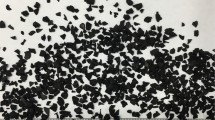Abstract
This paper investigates the possibility of using rubber waste from scrap tires as replacement of coarse aggregate in concrete. Performance of concrete mixtures incorporating 5, 10 and 15% of scrap rubber as volume replacement for coarse aggregate was investigated. Compressive strength, flexural strength, stress–strain behavior, workability, air content, water absorption and unit weight were evaluated using standard procedures. Thermal behavior for concrete was examined using hotbox technique. No remarkable changes in concrete properties up to 5% substitution were occurred. Beyond 5% substitution, concrete properties change appreciably. Compressive strength, flexure strength, workability, stiffness and unit weight of rubberized concrete decreased as rubber content increased. While impact resistance, air content and water absorption of rubberized concrete increased with increase in rubber content. Thermal performance of concrete containing rubber aggregate was improved, and promising results were obtained. Thus, rubberized concrete could be useful in slabs to improve energy efficiency of building unit.

Similar content being viewed by others
Referencs
Ganjian E., Khorami M., Maghsoudi A.A.: Scrap-tyre-rubber replacement for aggregate and filler in concrete. Constr. Build. Mater. 23, 1828–1836 (2009)
Waste Manager, 154 Buckingham Palace Road, London, 10 (1998)
Stutz, J.; Donahue, S.; Mintzer, E.; Cotter, A.: Recycled Rubber Products in Landscaping Applications, Resource and Environmental Strategies, Tellus Institute (2003)
Eldin, N.N.; Senouci, A.B.: Rubber_tyre particles as concrete aggregates. ASCE J. Mater. Civ. Eng. 478–496 (1993)
Li Z., Li F., Li J.S.L.: Properties of concrete incorporating rubber tyre particles. Mag. Concr. Res. 50(4), 297–304 (1998)
Siddique R., Naik T.R.: Properties of concrete containing scrap-tyre rubber—an overview. Waste Manage 24(1), 563–569 (2004)
Azmi, N.J.; Mohammed, B.S.; Al-Mattarneh, H.M.A.: Engineering properties of concrete containing recycled tire rubber. In: International Conference of Construction and Building Technology (2008)
Yilmaz A., Degirmenci N.: Possibility of using waste tire rubber and fly ash with Portland cement as construction materials. Waste Manag. 29, 1541–1546 (2009)
Guneyisi E., Gesoglu M., Ozturan T.: Properties of rubberized concretes containing silica fume. Cement Concr. Res. 34, 2309–2317 (2004)
Segre N., Joekes I.: Use of tyre rubber particles as addition to cement paste. Cement Concr. Res. 30(9), 1421–1425 (2000)
Park J.K., Edil T.B., Kim J.Y., Huh M., Lee Hoo S., Lee J.J.: Suitability of shredded tyres as a substitute for a landfill leachate collection medium. Waste Manag. Res. 21, 278–289 (2003)
Olivares H.F., Baluenga G.: Fire performance of recycled rubber filled high-strength concrete. Cement Concr. Res. 34, 109–117 (2004)
Marzouk O.Y., Dheilly R.M., Queneudec M.: Valorization of post-consumer waste plastic in cementitious concrete composites. Waste Manag. 27(2), 310–318 (2007)
ASTM C150/C150M - 11 “Standard Specification for Portland Cement” ASTM International, West Conshohocken, PA, 2011. doi:10.1520/C0150_C0150M-11, http://www.astm.org
ASTM C33-11 “Standard Specification for Concrete Aggregates” ASTM International, West Conshohocken, PA, 2011, doi:10.1520/C0033_C0033M-11, http://www.astm.org
ACI 211.1-03 “Standard Practice for Selecting Proportions for Normal, Heavyweight and Mass Concrete”
ASTM C39/C39M-12 “Standard Test Method for Compressive Strength of Cylindrical Concrete Specimens” ASTM International, West Conshohocken, PA, 2012, doi:10.1520/C0039_C0039M-12, http://www.astm.org
ASTM C78/C78M-10 “Standard Test Method for Flexural Strength of Concrete (Using Simple Beam with Third-Point Loading)” ASTM International, West Conshohocken, PA, 2010, doi:10.1520/C0078_C0078M-10, http://www.astm.org
ASTM C642-06 “Standard Test Method for Density, Absorption, and Voids in Hardened Concrete” ASTM International, West Conshohocken, PA, 2006, doi:10.1520/C0642-06, http://www.astm.org
ASTM C1363-11 “Standard Test Method for Thermal Performance of Building Materials and Envelope Assemblies by Means of a Hot Box Apparatus” ASTM International, West Conshohocken, PA, 2011, doi:10.1520/C1363-11, http://www.astm.org
Zheng L., Sharon Huo X., Yuan Y.: Experimental investigation on dynamic properties of rubberized concrete. Constr. Build. Mater. 22, 939–947 (2008)
Turatsinze A., Turatsinze A.: On the modulus of elasticity and strain capacity of Self-Compacting Concrete incorporating rubber aggregates. Resour. Conserv. Recycl. 52, 1209–1215 (2008)
Khorrami M., Vafai A., Khalilitabas A., Desai C.S., Majedi Ardakani M.H.: Experimental investigation on mechanical characteristics and environmental effects on rubber concrete. Int. J. Concr. Struct. Mater. 4(1), 17–23 (2010)
Topcu, I.B.: The properties of rubberized concretes. Cement Concr. Res. 25 (2), 304–310 (2007) (1995)
Aiello M.A., Leuzzi F.: Waste tyre rubberized concrete: properties at fresh and hardened state. Waste Manag. 30, 1696–1704 (2010)
Topcu I.B., Avcular N.: Analysis of rubberized concrete as a composite material. Cement Concr. Res. 27(8), 1135–1139 (1997)
Wesam Amer Aules: Utilization of crumb rubber as partial replacement in sand for cement mortar. Eur. J. Sci. Res. 51(2), 203–210 (2010)
Nehdi M., Khan A.: Cementitious composites containing recycled tire rubber: an overview of engineering properties and potential applications. Cement Concr. Aggreg. 23(1), 3–10 (2001)
Etebar, K.; Kew, H.Y.; Limbachiya, M.C.; Kenny, M.J.: Investigation into the potential of rubberized concrete products. In: Excellence in Concrete Construction through Innovation, Proceedings of the Conference Held at the Kingston University, United Kingdom, 9–10 Sept 2008
Yesilata B., Isıker Y., Turgut P.: Thermal insulation enhancement in concretes by adding waste PET and rubber pieces. Constr. Build. Mater. 23, 1878–1882 (2009)
Hall, M.R.; Najim, K.B.; Hopfe, C.J.: Transient thermal behaviour of crumb rubber-modified concrete and implications for thermal response and energy efficiency in buildings. Appl. Thermal. Eng. 33–34, 77–85 (2011)
Author information
Authors and Affiliations
Corresponding author
Rights and permissions
About this article
Cite this article
Shah, S.F.A., Naseer, A., Shah, A.A. et al. Evaluation of Thermal and Structural Behavior of Concrete Containing Rubber Aggregate. Arab J Sci Eng 39, 6919–6926 (2014). https://doi.org/10.1007/s13369-014-1294-1
Received:
Accepted:
Published:
Issue Date:
DOI: https://doi.org/10.1007/s13369-014-1294-1




